Kronosaurus could easily be called the comeback kid, having the distinction of being one of the first marine reptiles to ever be featured in toy form way back in the Marx sets only to be lost to obscurity for many decades after, then just recently came roaring back into the spotlight.Having fought (or swam) its way back into the top ten, this impressive giant surely is determined to edge out the mighty Mosasaurus. But there is only one problem: it hasn’t had a successful movie career yet that would propel it to super stardom status.
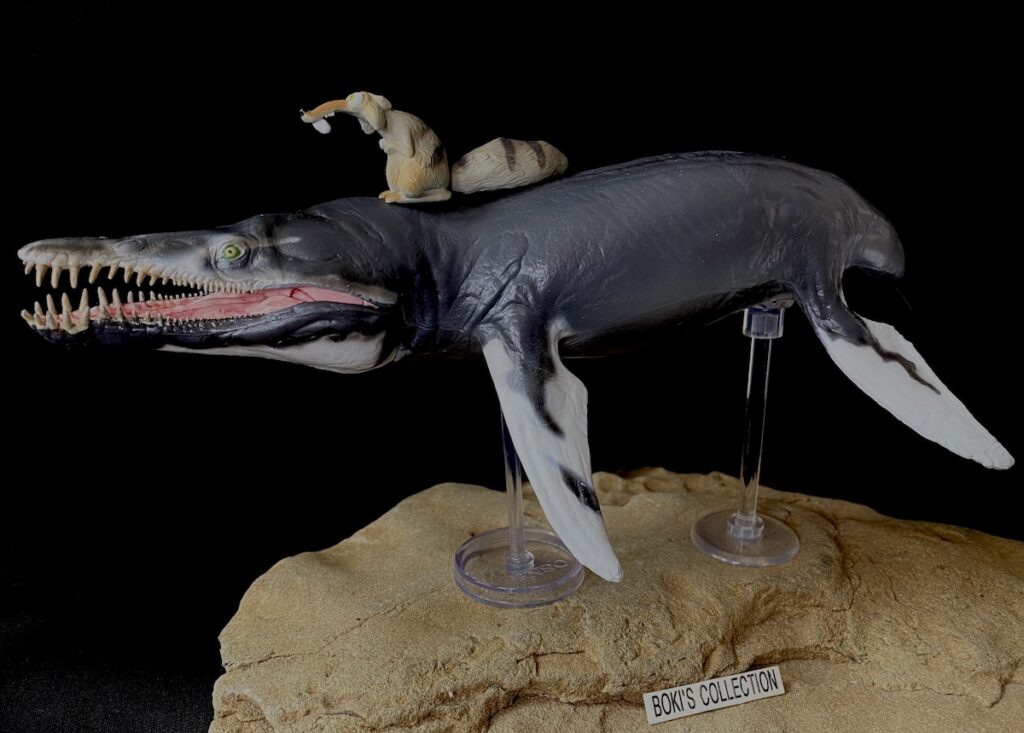
After being neglected for decades, in just the last four years, we have seen a renewed interest in this animal and as a result, we recently got at least 3 different new models from both CollectA, Safari, and one from an unknown brand. Today, we take a look at the latest model to come out, PNSO’s Jeff the Kronosaurus part of their Museum line series ( a new Marine Museum category was added) released this year.It is also the fourth marine reptile from them (Edit: after this writing, two additional marine reptiles have been announced!)
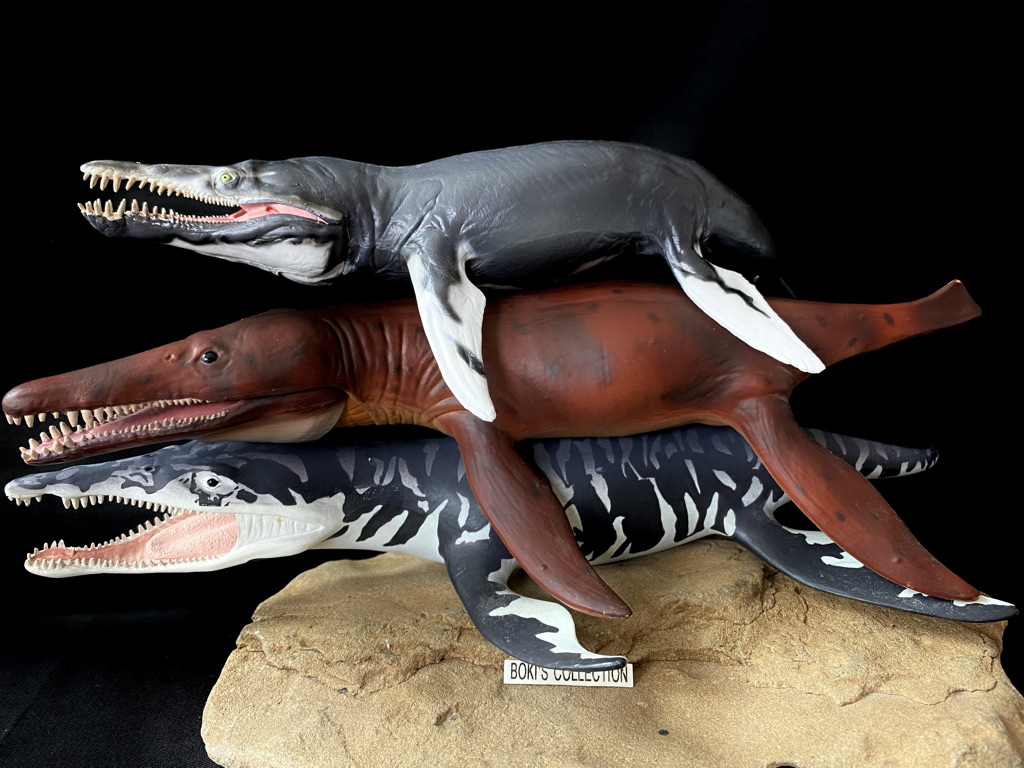
Although slightly shorter than the Mosasaurs, what it lacked in length it made up in bulk. Unlike the slender bodied, long tailed Mosasaurs, Kronosaurus like many of the large Pliosaur have bigger bodies and larger heads, short necks, stiff body, and a relatively short muscular tail. They dominated the early cretaceous seas and were the apex predators of that time before the Mosasaurs took over at the latter half of the Cretaceous.

Jeff the Kronosaurus is part of the Museum Line Series so it is much more expensive than the others. Kronosaurus was one of the largest of the Pliosaurs reaching a size estimate between 9-10 meters or 30-36 feet. As impressive as this size are, unfortunately PNSO opted to base this model on the smaller size range of 31 feet for a 1:35 scale model. It measures -11” inches long, far shorter than the Mosasaur which is really a shame, it would be different if this was part of the non-museum line, but it isn’t and that’s what’s disappointing about its size especially if displayed next to the huge Mosasaur! But not all figures are always going to be based on the largest specimen, so when seen with the mosasaur, it’s worth keeping that in mind. Still, it’s hard not to image and wish that this figure was just a bit larger to truly make it a showstopper.

After a long parade of large theropods, it’s nice to see PNSO switch attention and focus on another group like the marine reptiles. And just like the dinosaurs, this Kronosaur is packed with lots of details to feast on. What easily noticed on Kronosaurus and other Pliosaurs is just how huge their heads are compared to their body proportions.PNSO captured that essence perfectly and looking and comparing the model’s head to the skull restoration, it matches up pretty well. The teeth are beautifully and individually sculpted and interlock with each other precisely when the mouth is closed.The mouth comes articulated so you have the option of a closed or open mouth and it holds up really well at any position even when you shake it.

The details on the head and inside the mouth is well done. The eyes are striking in that it was given a green and yellow colors that really stands out against the dark skin color.The inside of the mouth has plenty of details and the way the flesh and soft tissues is sculpted and colored makes it look real, even down to small details such as veins. The huge tongue is connected to the lower jaw so when you fully open the mouth at the maximum, you will notice it sort of floats in the back and not connected at the base.

This is only visible at this extreme positioning of the lower jaw and only when you look very closely. Other than that, it’s not obvious and it’s understandable why it was attached this way (articulation).The paint application on the head including the teeth is precise and clean with very little bleeding, at least on my copy. The teeth are even colored yellowish and show some wear and tear instead of perfect pearly white that looks unnatural.

The body is robust as it should be and successfully convey the power it has. The musculature is nicely defined without exaggeration, and the scales are small, so small in fact that it looks very smooth or nonexistence. But despite the smoothness of the figure there are plenty of skin folds that really captures movement and muscle tension that add to the sense of movement. Pliosaurs body shape is unique and the closest we can compare them to are perhaps the whales, they are longer and bulkier than the long-necked plesiosaurs and the sinewy Mosasaurs. In fact, if you take out the back paddles of Kronosaurus,the body really resembles a whale.

The large and powerful paddles are beautifully sculpted with some even showing some fraying on the edges. The area that attaches to the body has ample muscles which is nice to see and even has skin folds definitions that suggest tension as they are stretched as the animal moves them. You can see the subtle outlines of the digits on these paddles as well. All of the paddles are oriented on a downward position as if the animal is swimming upwards from the depths. The paddles are given a white color that are broken by black stripes that looks really nice.

Long ago, the Walking With Dinosaur show popularized the black and white color scheme on large marine reptiles when they gave their Liopleurodon these colors. Since then, many pliosaurs have followed this same colors over and over again. While not exactly black and white, PNSO gave their Kronosaurus an overall body color that is a rich dark grey hue (not exactly black as it may first appears) on the majority of the body. This color is very similar to what we see in today’s extant humpback whale, no doubt the inspiration for this figure’s color scheme. The belly is white and there are also beautifully applied splotches of white on the upper jaw as well as under the lower one that blends in seamlessly with the darker color. In addition, some pink can be seen on the underside as well that adds some warmth. Like all PNSO figures, the variation in colors is all in the subtlety of hues and tones as well as how these are layered and applied that warrants a closer look rather than relying just on first impressions. Only upon closer examination would you appreciate the many shades and nuances of the colors. The countershading effect is appropriate for large marine ocean predators.
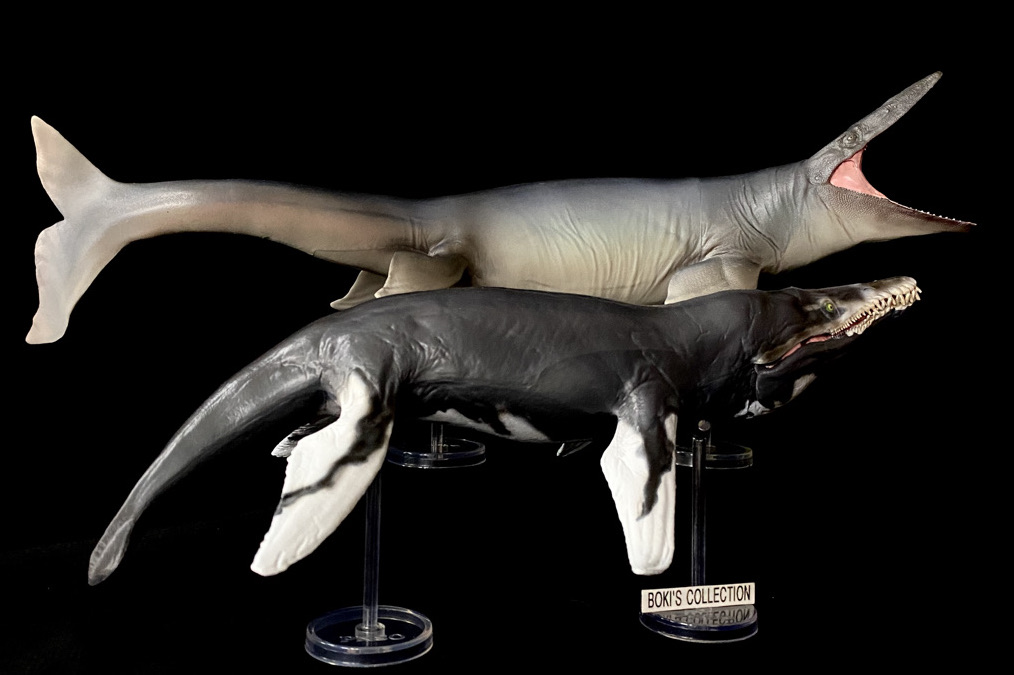
There has been a lot of discussions about the long neck on plesiosaurs and what evolutionary advantages these extremes have, same goes with how these animals moved their enormous paddles to propel themselves in water. Although we had made great progress in understanding how these unique features were used, the debate is still far from settled.The tail on the other hand was somewhat left out in these discussions for a long time but it has recently gained attention.

I am not an expert on marine reptiles and I was used to and grew up with the image of plesiosaurs and pliosaurs having a short pointy tail. When images of tail fin started to appear in paleoart and some figures a few years ago, I was under the impression that this was a new phenomenon. As it turns out, this was not the case at all, the idea of a tail fin on non-ichthyosaurs goes way back and is nothing new. Today, tail fin has become a common feature on recent models of long-necked plesiosaurs and mosasaurs and even some pliosaurs which bring us back to what really sets this PNSO model apart from all others: its unique tail fluke.

When PNSO first unveiled photos of this model, the first thing that really stood out is how its tail fluke looks, I’m sure I wasn’t the only one who found this odd and was left scratching my head wondering what on Cretaceous seas is going on there.Instead of the vertical tail fin we have become used to seeing, we see a small horizontal tail fluke, something we haven’t seen on a model before. As expected, the first reaction was to quickly label the model as inaccurate and accuse PNSO of going too far in their artistic license or speculation.
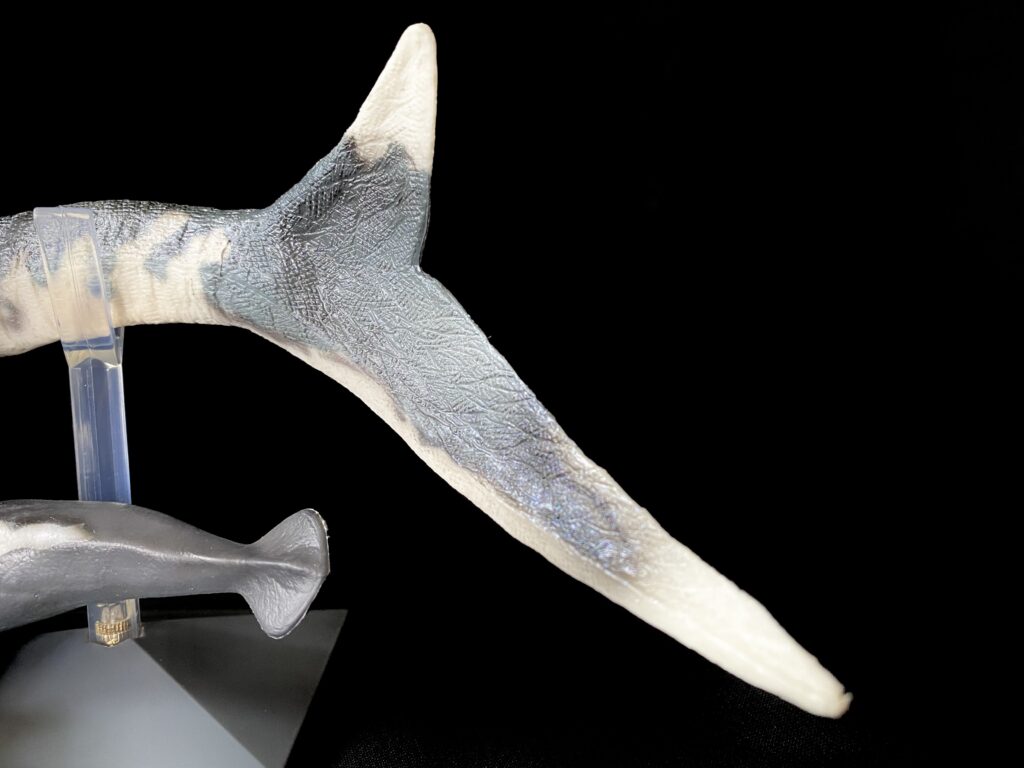
But as it turns out, this is not something that PNSO just pulled out of thin air, and the possibility of horizontal tail fluke was not a new thing as I would soon find out, but rather something that has been around for a long time but just hasn’t gained much attention or discussion. There are even some fossils of marine reptiles that suggest an outline of a possible tail fluke in a horizontal orientation.
The exact function of a tail fin on non-ichthyosaur marine reptiles is still pretty much open for interpretation; many thinks that it acted like a rudder that helps stabilize the animal as it swims and turn underwater especially with such wide and rigid bodies that lacked dorsal fins (that we know of). This made a lot of sense for the long-necked plesiosaurs as a counterbalance for their extremely long necks, as well as the long tailed mosasaurs that probably moved their tails in a side-to-side fashion when swimming.

The short necked pliosaurs on the other hand, with their longer and muscular body, offered another possibility. The body shape of pliosaurs is built more like that of a whale than a shark especially when you look at the longer, wider, and muscular tail. This led some researches o suggest that perhaps they moved their tail in a vertical (up and down)motion like whales do instead of the side-to-side we see in sharks, crocodiles, ichthyosaurs, and mosasaurs. And perhaps just like whales they had a horizontal tail fluke at the tip instead of a vertical fin that helped propel them.This theory is what led PNSO to give their Kronosaurus this unusual and unique tail fluke.

The tail fluke is an interesting and novel thing to see on a pliosaur. On the figure, the tail fluke is flattened and shaped like that of what see see in a dugong or manatee more rounded. And to help convey its function, the muscular tail with bulging muscles outlines is posed in a downstroke fashion with a nice curvature. If you take out the paddles, you could easily see the reference to how whales moved their tail.

This tail fluke looks small in proportion to the body, they could have made it a bit larger perhaps, but again, with four large paddles, Kronosaurus may not have needed a larger tail fluke to help propel it, maybe the experts can chime in on this. This new tail fluke interpretation we see in this model is really interesting and really makes this figure so unique. When CollectA released their version of Kronosaurus they gave it the more popular vertical tail fin while Safari chose the more conservative and rather safe pointed tail without any fins at all, so with the addition of this PNSO model we now have a nice sampling of the various tail fin/fluke possibilities and its evolution in how Kronosaurus’s tail is depicted in toy form.
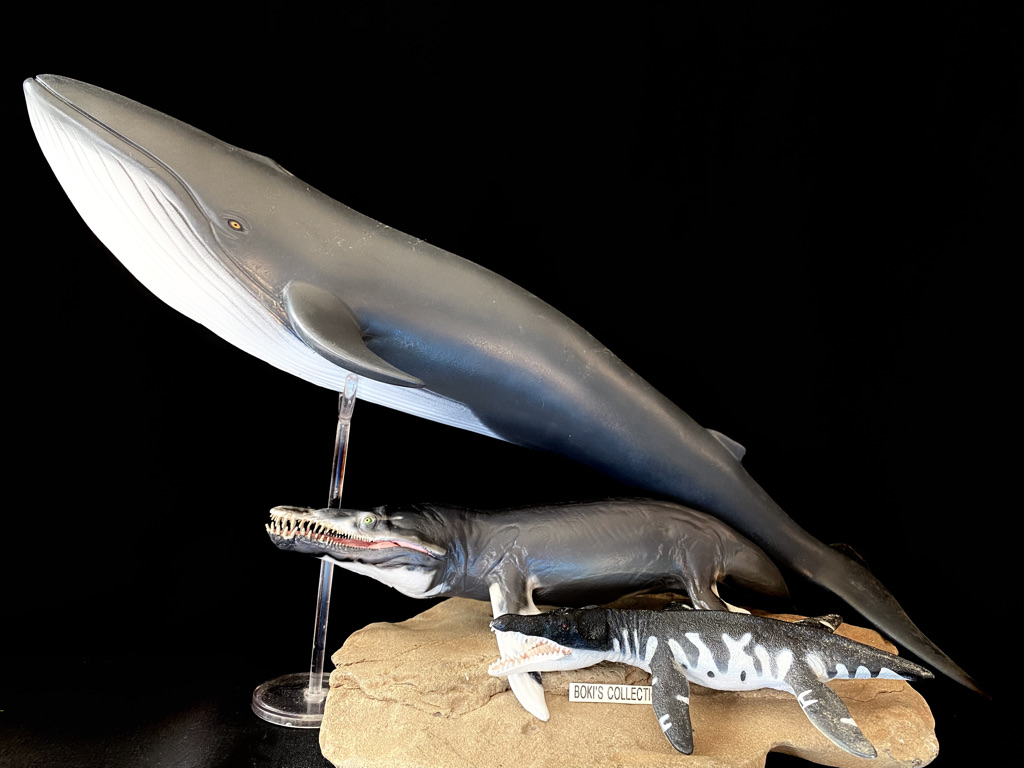
I love that PNSO went this route with the tail fluke interpretation as it captures another possibility that is rarely depicted and made this model unique, interesting, and exciting. No doubt more information about horizontal tail fluke will come to light as more research are done, and perhaps even finding a fossil that clearly illustrate this feature.In a way, despite the idea of horizontal tail fluke being around for decades, the debate is just starting to filter to the masses. While some may view or judge this model’s tail fluke as odd or even inaccurate now, I wouldn’t be quick to dismiss it, for who knows, this could very well be the standard in just a few years from now. And if it gets debunked, this model is still significant and will serve as a record of this fascinating possibility of an alternate tail fluke that we can look back at.
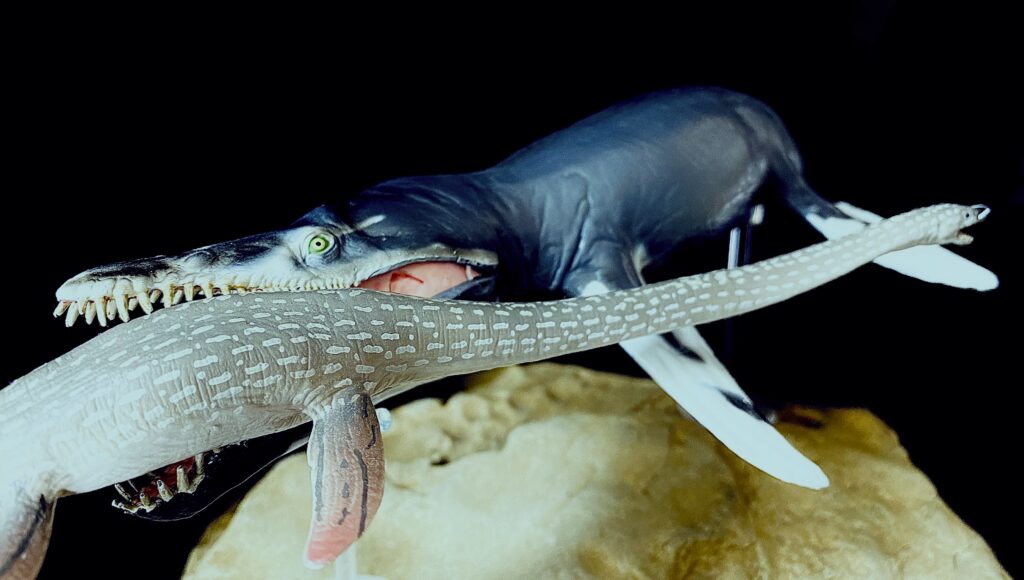
Plesiosaurs and other marine reptiles are fascinating and uniquely built that we simply have no extant animals to compare them with today. How these unique features such as long necks, large paddles, and strong tails moved in a coordinated way to propel the animal as it swims is still largely a mystery.
PNSO continues to impress me with their models and Jeff the Kronosaurus is certainly a testament to their creativity and risk-taking.Despite its smaller size, it certainly commands attention and surely dominate a display shelf with its presence. This figure now has taken on the top spot as the representative on my limited display shelf and has quickly become one of my favorite marine reptile model in my collection. Its curious tail fluke makes it unique among all other versions out there and make for a good conversation piece.It is priced rather high as it was released under the Museum Line series which may discourage some in purchasing it which is understandable. But for those looking for one impressive marine reptile centerpiece, this model could be the perfect option to fill in that coveted spot especially if space is limited.

That concludes this review of Jeff the Kronosaurus from PNSO. I hope you enjoyed it and thanks for checking it out. Until we meet again on the next review, stay safe and healthy. Cheers!
Epilogue: Long after finishing this review (it sat for a while since I’m way behind), Mark Witton published on his blog a comprehensive and detailed look at this whole tail fin/fluke on plesiosaurs phenomenon! It was great timing that really helps understand where PNSO got this idea. Mark’s blog post is full of fascinating information and I encourage you to read it.http://markwitton-com.blogspot.com/2021/09/a-tale-of-plesiosaur-tails-vertical.html
Support the Dinosaur Toy Blog by making dino-purchases through these links to Ebay and Amazon. Disclaimer: links to Ebay.com and Amazon.com on the Dinosaur Toy Blog are often affiliate links, when you make purchases through these links we may make a commission


Kronosaurs had a role in Steve Altens sequel to Meg,The Trench.If the sequel to 2018s movie The Meg is made,I hope the writers and directors fellow that thread.
Good review. But it is sad how the PNSO Kronosaurus is about twice the price of the CollectA and Safari versions, yet so much smaller.
I have to wonder if the days of the “affordable” PNSO toys are behind us. Admittedly I was always puzzled as to how they could afford to sell toys with that level of detail in a full color box with a full color booklet for just over $20, but perhaps it wasn’t sustainable.
It does look like Cretoxyrhina is in that $22.99 price point range, but not eligible for Prime shipping on Amazon, so you gotta factor in $10 extra.
In fairness to PNSO, they typically don’t put figures on Prime until several months after release. If it’s not on Prime by 2022 then I would say that they are factoring in the shipping for that.
It is a very well accomplished and finished figure. I highlight above all the beauty of the teeth, well sculpted and exquisitely painted. It would have been appreciated that PNSO had made it in a larger size.
Great review as usual! The debate about the horizontal caudal fin is actually not that sharp. Pliosaurs swam in the same way as modern seals, flapping their flippers and helping with their tail, if any (like whales). Ichthyosaurs and Mosasaurs relied on body bends and side-to-side tail strokes. The swimming principle for these groups is fundamentally different. So the PNSO are right as always. In the case of the Kronosaurus, it’s especially nice that the sculptor has given up the terrible wrinkled skin like their Mosasaurus! All the same, the sea animal should be streamlined. What is forgivable for land animals is unacceptable for marine animals. Thanks again for the review, good luck! Do not be ill!